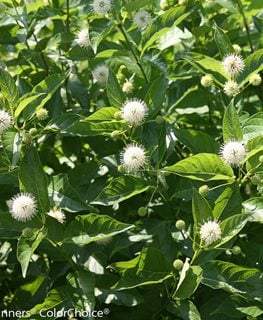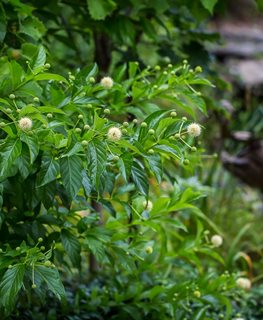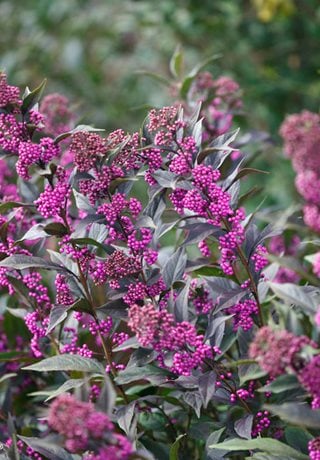HOW TO GROW & CARE FOR BUTTONBUSH
With year-round appeal and intriguing ornamental features, this wildlife-friendly shrub makes an invaluable addition to home landscapes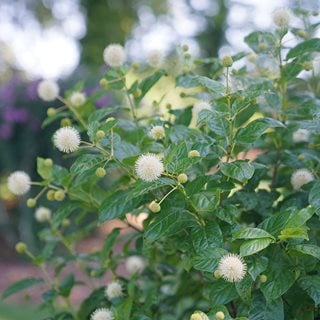
Sugar Shack® buttonbush. Photo: Proven Winners
Cephalanthus is an ornamental garden plant with glossy green leaves; fragrant white flowers; tan, brown, or red fruits; fall color; and an attractive structure, offering four-season appeal in the landscape. This native shrub provides food, shelter, and nesting habitat for a wide array of beneficial insects, birds, and other wildlife, making buttonbush one of the best plants for native gardens, pollinator borders, and other natural areas.
Also known as button willow, honeybells, or common buttonbush, this hardy deciduous bush is native to most of the lower 48 states, Canada, and Central America, where it typically grows in low-lying wet areas such as swamps, thickets, bottomlands, and along streams and ponds. This medium- to fast-growing shrub can tolerate shallow standing water, making it a common choice for wetland restoration projects, erosion control, and rain gardens.
Cephalanthus tolerates a wide range of growing conditions and is virtually carefree once established. Here’s how to grow and use buttonbush in your yard.
On this page: Basics | Planting | Care | Varieties | Frequently Asked Questions | Landscaping Ideas
On this page:
- BASICS
- HOW TO PLANT BUTTONBUSH
- BUTTONBUSH CARE
- BUTTONBUSH VARIETIES
- FREQUENTLY ASKED QUESTIONS
- DESIGN IDEAS
BUTTONBUSH BASICS
Botanical name:
Cephalanthus occidentalis
Plant type:
Multi-stemmed deciduous shrub or small tree
Zones:
4-10
Exposure:
Full sun to part shade
Habit:
Upright rounded habit
Height/Spread:
4 to 12 feet tall and wide
Bloom time:
Late spring to early fall, depending on the climate
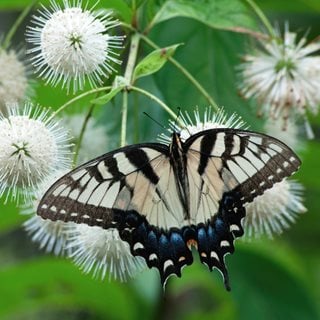
Tiger swallowtail on buttonbush. Photo: Donna Bollenbach / Shutterstock.
Flowers:
Unique white or pale pink flower heads 1 to 1-1/2 inches across are perfectly globe-shaped, containing clusters of small tubular florets. Cephalanthus flower heads are studded with slender round-headed pistils for a pincushion effect. Flowers exude a sweet honey-like fragrance that entices a wide range of pollinators.
Fruit:
Flowers mature into hard button-like seed balls in late summer, starting out reddish-brown and fading to brown. The fruits persist into winter.
Foliage:
Oval-shaped deciduous leaves 4 to 6 inches long are dark green with a glossy sheen. Some varieties produce chartreuse or red new growth, with yellow, bronze, or red fall color.
Wildlife benefits:
The nectar from Cephalanthus flowers is an important food source for hummingbirds, honeybees, bumble bees, moths, and many types of butterflies, including tiger swallowtails, skippers, painted ladies, and monarchs. Seeds are a late-season food source for songbirds and waterfowl, including ducks and loons. The dense bushy growth habit provides protection for nesting wood ducks. Cephalanthus is a host plant for the titan sphinx moth, hydrangea sphinx moth, silk moths, and wood nymphs.
HOW TO PLANT BUTTONBUSH
When to plant:
Plant buttonbush during milder months in spring or fall to avoid stress from extreme heat or cold.
Where to plant:
Choose a site with full sun to partial shade. Buttonbush performs best in rich, well-draining soil, but it can also tolerate a bit of standing water.
How to plant:
Loosen soil in the planting area and amend with compost or other organic matter. Dig a hole twice as wide and the same depth as the root ball. Remove plant from the nursery container and tease out roots if potbound. Place in the hole so the top of the root ball is level with the surrounding soil. Fill in the hole with soil, tamp down gently and water thoroughly to remove air pockets. Water regularly until plants are established. Space plants 4 to 12 feet apart, depending on the variety.
BUTTONBUSH CARE
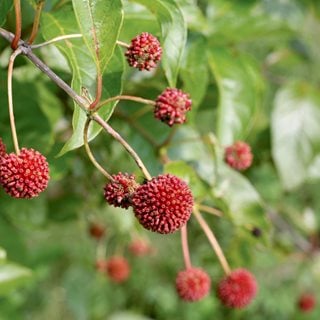
Buttonbush seed pod. Photo: Proven Winners
Soil:
Cephalanthus is tolerant of a wide range of soil types, including clay, loam, and sand. Plants perform best in rich, well-draining soil with a neutral to slightly acidic pH of 6.8-7.2. For containers, use a high quality all-purpose potting mix.
Amendments & fertilizer:
In late winter or early spring, apply a granular slow-release fertilizer especially formulated for trees and shrubs. Plants can be lightly mulched with compost or other organic matter to suppress weeds, retain moisture, provide supplemental nutrients, and keep roots cool.
Watering:
Cephalanthus is tolerant of wet soil and performs best in soil that is kept evenly moist. Don’t allow soil to dry out. Provide supplemental water as needed during prolonged heat or dry spells.
Pruning:
Cephalanthus blooms on new wood formed on the current season’s growth. In late winter or early spring, remove dead, broken, or diseased branches and shape plants as needed. Lower branches can be removed to train into a tree form. If plants become unmanageable, they can be cut back to near the ground in spring to rejuvenate.
Pests and diseases:
When grown in the right conditions, buttonbush is free of most pests and diseases. Pests include leafhoppers, lygus bugs, and thrips. Diseases include brown leaf spot.
BUTTONBUSH VARIETIES
SUGAR SHACK® —
Cephalanthus occidentalis
Zones: 4-10
Habit: Compact bushy habit
Height/Spread: 4 to 5 feet tall and wide
Bloom time: Early to late summer
Color: White flowers, green foliage, red fruit
This award-winning variety is more compact than many other buttonbush shrubs, making it suitable for smaller spaces. Glossy new foliage is red, fading to green, with burgundy fall color. Lightly fragrant, creamy white flowers are followed by bright red seed pods—one of the few varieties with reliably red seed pods. Use in a foundation planting, native garden, or as hedging.
'SPUTNIK' (syn. 'Bieberich')
Cephalanthus occidentalis 'Sputnik'
Zones: 4-10
Habit: Bushy spreading habit
Height/Spread: 5 to 12 feet tall, 6 to 12 feet wide
Bloom time: Summer
Color: Shell-pink flowers, green foliage, brown fruit
Pale pinkish-white flowers are produced on plants with glossy green leaves and an attractive growth habit. Foliage emerges chartreuse, fading to green before turning coppery-bronze in fall. This larger variety is suitable in a mixed border, woodland garden, or as a stand-alone focal point.
Also try:
'FIBER OPTICS' (syn. 'Bailoptics')
Cephalanthus occidentalis 'Fiber Optics'
Zones: 4-9
Habit: Compact bushy habit
Height/Spread: 5 to 6 feet tall and wide
Bloom time: Late spring to early summer
Color: White flowers, green foliage, reddish-brown fruit
‘Fiber Optics’, named for the unusual flowers with fiber-like pistils, is an improved variety with finer foliage and a more compact habit suitable for smaller yards. Glossy green foliage turns yellow in fall. Use in a foundation planting, mixed border or wildlife garden.
'MAGICAL MOONLIGHT' (syn. 'Kolmoon')
Cephalanthus occidentalis 'Magical Moonlight' Zones: 5-9
Habit: Upright bushy habit
Height/Spread: 5 to 8 feet tall, 4 to 6 feet wide
Bloom time: Late spring to summer
Color: White flowers, green foliage, brown fruit
‘Magical Moonlight’ stays more compact than other varieties, adding versatility to smaller spaces. Shiny green leaves turn a glowing moonlight yellow in autumn. The neat rounded form provides attractive structure to foundation plantings, native gardens, and shrub borders.
FREQUENTLY ASKED QUESTIONS
Where is the best place to plant buttonbush?
Buttonbush prefers a site with full sun to partial shade and moist soil.
Is buttonbush poisonous?
Buttonbush contains cephalanthin, a toxic compound that can be harmful to livestock, pets, and children if ingested. Symptoms include vomiting, convulsions and paralysis. If you suspect your child or pet has ingested any part of the plant, contact your local poison control center, doctor or veterinarian.
Do deer eat buttonbush?
Buttonbush plant is moderately deer resistant and may experience some deer browse, especially if other food sources are scarce.
What does buttonbush look like in winter?
Buttonbush in winter is bare of leaves, revealing the textured gray bark and twisting branches that lend structural interest to the landscape.
Do hummingbirds like buttonbush?
Buttonbush flowers are a rich nectar food source and exude a sweet fragrance, attracting many pollinators including hummingbirds.
BUTTONBUSH LANDSCAPING TIPS
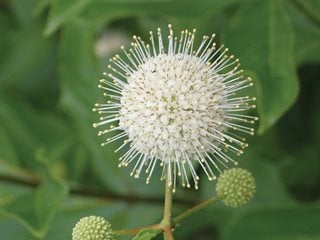
Photo: Proven Winners
For borders and landscapes:
Use buttonbush for wetlands and bogs, along streams and ponds, in a native or rain garden, shrub border, foundation planting, as hedging or screening.
For slopes and hillsides:
Buttonbush is useful for controlling erosion and water runoff on slopes or hillsides.
For containers:
Place a smaller buttonbush specimen in a container by itself and make sure containers have adequate drainage holes.
There are many ways to use buttonbush in your landscape. Here’s how:
- Plant along a stream bank or pond as part of a wetland restoration.
- Place in a rain garden alongside other plants that thrive in wet soils such as rose mallow, chokeberry, and leopard plant (Ligularia). (Find more rain garden plants.)
- Add buttonbush to a pollinator-friendly garden with other plants such as aster, blazing star, milkweed and summersweet. (Find more pollinator plants.)
- Include buttonbush in a native border alongside other native plants to provide food, shelter, and nesting habitat for birds, beneficial insects, and other wildlife.
- Site buttonbush in a low area of your yard where water collects for an easy-care solution to boggy soil.
- Plant buttonbush in a shrub border along a property line for privacy screening.
- Site buttonbush alongside winter blooming plants such as witch hazel, hellebores and early bulbs to enjoy the plant structure in winter.
- Use buttonbush shrubs to separate garden areas.
- Plant a smaller specimen in a decorative container and use as a focal point.
- Include a compact variety in a foundation planting alongside other shrubs that flower at different times for season-long color.
- Plant buttonbush in an island bed for a stunning focal point in the landscape.
Companion plants: Buttonbush combines well with many other shrubs, trees, and perennials that thrive in the same growing conditions. Good companions include aster, bee balm, dogwood, elderberry, ferns, goldenrod, ironweed, milkweed, Joe pye weed, ninebark, red maple, river birch, sweetspire, and viburnum.
RELATED:
Shrubs 101
Low-Maintenance Shrubs for Your Garden
16 Best Flowering Shrubs
